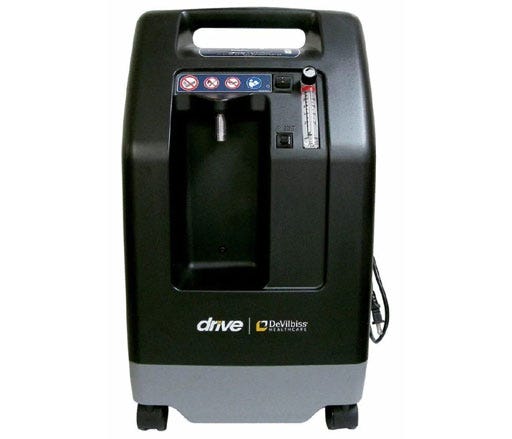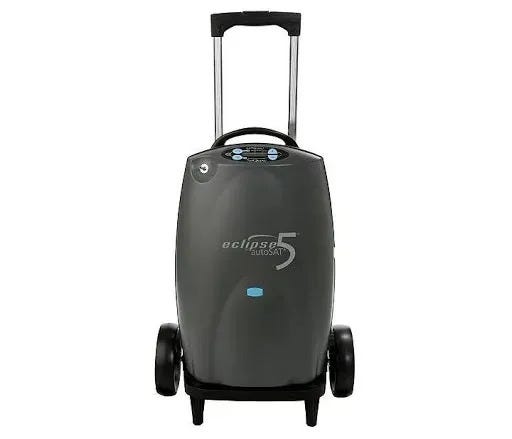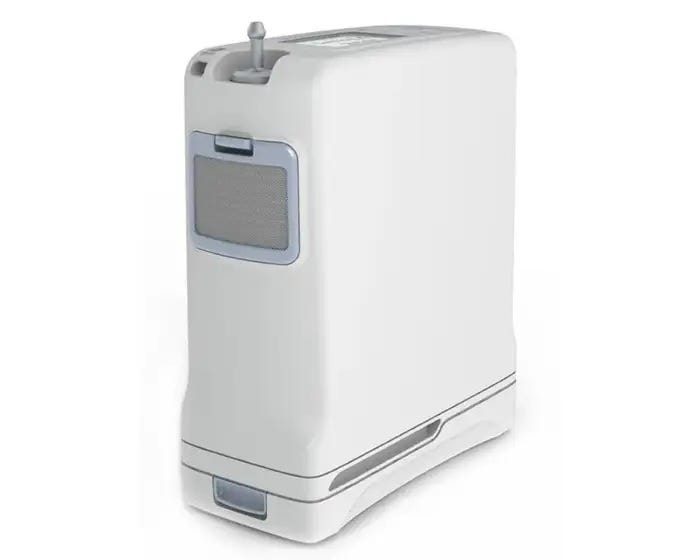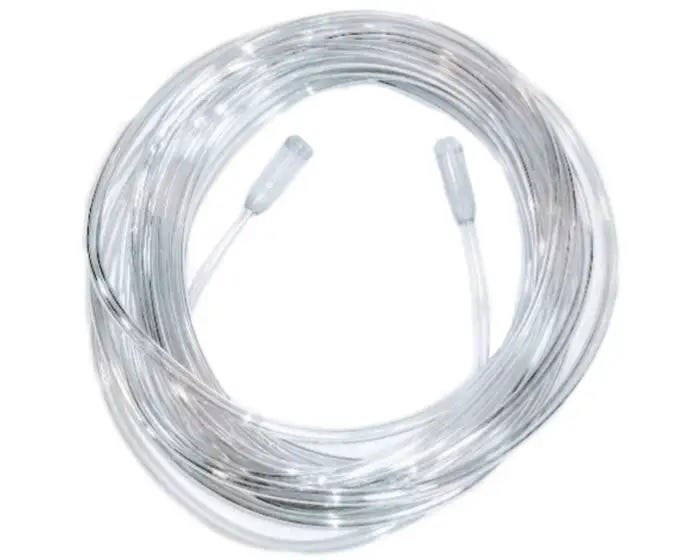Oxygen Concentrators
Oxygen concentrators provide supplemental oxygen to those who need it. They increase the freedom, independence, and versatility of users while also assisting them in breathing easier. Doctors prescribe oxygen concentrators to help their patients who have chronic lung diseases and other respiratory illnesses. Using an oxygen concentrator allows patients to continue their daily routine while using supplemental oxygen. The Oxygen Concentrator Supplies Shop has a wide range of oxygen concentrators for sale that will fit into your lifestyle, no matter your oxygen therapy needs.
Types of Oxygen Concentrators
Home Oxygen Concentrator


During a typical day, the average person breathes nearly 25,000 times without even thinking about it. However, not everyone can breathe that easily. Those suffering from respiratory illnesses may require supplemental oxygen. A home oxygen concentrator is the preferred solution for delivering the necessary oxygen flow in the comfort of a person’s own home. These provide stationary oxygen and operate from electricity in a wall outlet.
Portable Oxygen Concentrator


A portable oxygen concentrator delivers supplemental oxygen to therapy patients while traveling or on the go. This type of oxygen concentrator is smaller and more lightweight than home concentrators. Portable oxygen concentrators are compact enough to be carried around and most are FAA-approved for in-flight use. Additionally, portable oxygen concentrators can operate from a battery for added portability. The use of a portable oxygen concentrator allows patients to continue living their active lifestyles.
Pulse Dose & Continuous Flow Oxygen Concentrators
Patients with respiratory illness may require supplemental medical oxygen. When your physician writes a prescription, it will indicate the number of liters of oxygen delivered per minute (LPM) that you require. The LPM required will help determine whether a pulse dose or continuous flow oxygen concentrator best suits your needs, typically available with a 5LPM or 10LPM capacity. Here’s how the two types of devices work. There are two types of oxygen delivery for portable concentrators.
Pulse Dose Oxygen Concentrators


Pulse dose oxygen concentrations deliver oxygen during a person’s inhalation. This oxygen flow is ideal for treating respiratory conditions that do not require a high LPM. The prescription written by a person’s doctor will indicate what pulse setting the patient should use. The biggest benefit of using a pulse dose concentrator is that it works with a person’s breathing needs as they change. Additionally, pulse dose oxygen concentrators are usually compact and lightweight, so they are highly portable and easy to bring around.
Pulse dose oxygen concentrators stop as a person exhales, which means the concentrator uses less effort and therefore reduces battery use.
The Oxygen Concentrator Supplies Shop offers various pulse dose setting oxygen concentrators that patients can choose from to fit their prescription needs best.
Continuous Flow Oxygen Concentrators


Continuous flow oxygen concentrators deliver a constant flow of oxygen to the therapy patient, regardless of inhalation or exhalation. They deliver a steady flow of oxygen the whole time it is running. This type of concentrator is best for those who require a higher LPM. Since this type of concentrator is on all the time, it requires more parts and weighs more than pulse dose concentrators. In most cases, the therapy range for constant flow is between 1-3 LPM. CPAP and BiPAP machines are compatible with continuous flow portable oxygen concentrators. To make moving them around easier, they generally come with a wheeled cart or a retractable handle.
Shop for an Oxygen Concentrator by Brand
Oxygen Concentrator FAQs
What is an oxygen concentrator?
An oxygen concentrator device uses a battery or plugs into an outlet to receive, purify, and distribute air for those who have a low level of oxygen in their blood. These devices are lighter and less bulky than traditional oxygen tanks. They can lead to a more active lifestyle for those who have additional oxygen needs.
How does an oxygen concentrator work?
Normal air consists of 80% nitrogen and 20% oxygen. This is not an issue for people who have normal levels of oxygen in their blood. However, some individuals with low levels struggle with converting normal air into the oxygen their bodies need. An oxygen concentrator takes regular air and purifies it to 90-95% oxygen. To do this, the concentrator uses a compressor that moves air into sieve bed filters to remove the nitrogen. It then distributes the purified oxygen through hoses inserted into the nostrils. The nitrogen is later released back into the air.
There are two different types of oxygen concentrators: home and portable. These machines differ in size, weight, flow, power, and capacity.
What is an oxygen concentrator used for?
Doctors prescribe oxygen concentrators for a number of respiratory illnesses. They include, but are not limited to:
- chronic obstructive pulmonary disease (COPD)
- pneumonia
- asthma
- cystic fibrosis
- lung disease
How to use an oxygen concentrator?
- Keep the filter clean. When it gets dirty, wash it with soapy water. Wipe it and pat dry before reinstalling it in the oxygen concentrator.
- Check to see if the alarm functionality is available on your oxygen concentrator. If you don't hear a buzzer when you turn on the machine, contact the oxygen provider for help.
- Your health-care professional can explain how to tailor your prescribed flow to suit your particular specifications.
- When the humidifier bottle runs out of purified water, refill it as required, which may be many times a day.
- To start getting oxygen, connect the hose, plug in the concentrator, switch on the battery, and put on the breathing apparatus.
Pulse dose vs. continuous flow oxygen concentrators–which to buy?
Oxygen concentrators require a valid prescription from a doctor in order to purchase. Before selecting a device, be sure to discuss your oxygen needs with a physician.
Continuous flow oxygen is generally used for patients with a more severe chronic respiratory condition. For some users, continuous flow oxygen may also need to be combined with CPAP therapy. Pulse dose oxygen, on the other hand, is a great tool for users with less severe conditions. Pulse dose oxygen delivery cannot be used with CPAP therapy.
Some oxygen units are able to provide both continuous flow and pulse dose delivery. For those units, it is important to note that 2.0 LPM of continuous flow oxygen does not equal a pulse dose setting of 2. Talk to your doctor to determine the appropriate number for each setting.
Do oxygen concentrators require a prescription?
In accordance with the US Food & Drug Administration (FDA), oxygen concentrators are considered a Class II Medical Device. This means that you must have a valid prescription from a board-certified doctor in order to purchase one.
How long do oxygen concentrators last?
The lifespan of an oxygen concentrator is determined by a number of factors. Temperature, relative humidity, the cleanliness of the space it's in, and how much it's used are all factors. It is believed that older, heavier concentrators appear to last longer, with an average of 15,000 to 20,000 hours of operation before needing to be rebuilt. Although newer, lightweight machines are still durable, they only last 8,000 to 10,000 hours on average because their pieces are usually smaller and wear out more quickly.
Are oxygen concentrators covered by insurance?
At The Oxygen Concentrator Supplies Shop , we do not accept insurance. However, we can provide an itemized invoice with appropriate billing codes if you choose to submit for reimbursement with your insurance.
What does an oxygen concentrator do?
An oxygen concentrator works in a fairly straightforward manner. The machine draws air in and sends it through a compressor. The compressed air is pumped into a two-prong sieve bed filter system. Nitrogen is separated in the first sieve bed and oxygen is forced into the tank by compressed air. The compressed air shifts to the second sieve bed after the first bed is filled with nitrogen. It treats lung diseases like COPD, asthma, cystic fibrosis, etc.
What are the benefits of buying oxygen concentrators online?
- Wide range of products from different brands are available
- You get expert online support to choose best machine in your budget
- Security & privacy is ensured
- You can easily buy from home
- Cost efficient
- You become eligible for additional rewards
Do oxygen concentrators need maintenance?
Maintaining your oxygen device means that it can last you many years without needing too much attention. Because oxygen concentrators can be costly, regular maintenance will help prolong their service life. Like most machines, oxygen concentrators need maintenance. Fortunately, modern designs and intuitive user-friendly engineering have made cleaning and maintenance routines easy. Portable oxygen concentrators may need extra maintenance as they are carried outside of the home. However, the cleaning and maintenance process is simple.
- Clean the exterior of the device with a damp cloth and mild cleaner. Be sure the oxygen concentrator is unplugged.
- Dampen a cloth in a solution of mild cleaner and water to clean accessories like the carrying case.
- Follow the specific recommendations from the manufacturer for cleaning cannula and tubing
- Be sure to also follow recommendations for cannula and tube replacement as needed (usually every 3 to 6 months)
- Follow manufacturer guidelines for changing air intake filters
Additionally, portable oxygen concentrators rely on battery power to give you the oxygen therapy you need wherever you go. Regularly charging and caring for your concentrator’s battery is important. Don’t let it get wet and be sure to fully charge it prior to its first use.
While your home oxygen concentrator may not experience the dust and dirt of the outdoors, it still requires regular cleaning and maintenance. Much like a portable oxygen concentrator, the exterior of the machine needs to be cleaned. Cannula and tubing need to be cleaned regularly and replaced based on manufacturer recommendations. Air intake filters need to be replaced.
Every oxygen concentrator varies in design, so following the guidelines of your manual ensures the best maintenance for your machine.
To reduce dirt and dust buildup on your machine, keep your home oxygen concentrator away from corners and walls. Air filters can get clogged if the concentrator is placed in a poorly ventilated location.
What are the benefits of maintaining an oxygen concentrator?
Following a regular cleaning and maintenance schedule will make a difference. Cannula and tubing especially can attract bacteria and germs and cause illness if not cleaned immediately. When cannula and tubing is overused, cracks and damage can form and reduce overall performance. So, replacing these items in a timely manner is important.
Changing the filters ensures that airflow is consistent and uninterrupted so that your oxygen concentrator performs at its best to keep you healthy. Lastly, it may not hurt to have multiple batteries for your portable device.
How to maintain an oxygen concentrator ?
Get rid of the dust - Dust anywhere around an oxygen concentrator can be drawn into air intakes or end up in the cannula and tubing. Try to minimize dust as much as possible to maintain lasting oxygen concentrator performance.
Avoid overusing - Your oxygen concentrator is essential for your respiratory health, but if possible do not overuse your machine. Constant use wears out parts and the compressor. Try to limit use to as needed.
Some basic precautions - Avoid blocking intake air vents. Regularly check connections between tubes and the oxygen supply to look for leaks. If you use a humidifier with your oxygen concentrator, be sure to use only clean, distilled water.





